(麻省理工)电力推进—等离子体(以及电弧)引擎概述
等离子发动机 算式

等离子发动机算式等离子发动机(Plasma Engine)是一种以等离子体作为推进剂的发动机。
它利用电离气体产生的等离子体的高温高压特性,以产生推力,用于航天器或飞行器的推进。
本文将介绍等离子发动机的工作原理、应用领域、优点和挑战等方面,以及相关的计算公式。
一、工作原理等离子发动机的工作原理基于电离气体的物理特性。
当气体中的原子或分子受到高能电子或能量释放时,它们将失去或获得电子,从而形成电离态的气体,即等离子体。
等离子体具有高温高压、电磁性和导电性等特性,能量较高的等离子体可以产生较大的推力。
等离子发动机利用电离气体产生等离子体,并通过电磁场将等离子体加热到高温高压状态。
然后,利用磁场或电场的力来加速和排斥等离子体,并通过喷嘴将高温高压气体喷出,从而产生推力。
等离子体排出后,通过引擎的后向反作用力使航天器或飞行器前进。
二、应用领域等离子发动机主要应用于太空探索领域,特别是对于长时间太空探索任务具有重要意义。
由于等离子发动机具有高效推进、高经济性和长寿命等优点,因此被用于推动航天器在太空中进行精确的姿态控制、推进和轨道修正。
此外,等离子发动机还可用于科学实验室的等离子体物理实验研究。
三、优点和挑战等离子发动机相较于传统火箭发动机具有以下优点:1.高效推进:等离子发动机能够将燃料的利用效率提高到60-70%以上,远高于传统火箭发动机的20-30%。
2.长寿命:等离子发动机的电离器和喷嘴由于不直接暴露在高温高压的燃烧气体中,因此寿命更长,维护成本更低。
3.节省燃料:等离子发动机所需燃料量相对较少,能够在长时间航天任务中进行持续推进。
等离子发动机也面临一些挑战:1.高能耗:为了产生足够高的温度和压力,等离子发动机需要耗费大量的电能,因此能源供应是一个关键挑战。
2.产生电磁辐射:高能等离子体的产生和加速过程会产生电磁辐射,对航天器的其他设备和电子系统可能造成干扰,需要额外的电磁屏蔽措施。
3.研发和制造成本高:由于等离子发动机属于先进技术,研发和制造成本相对较高,限制了其大规模应用的进程。
等离子体
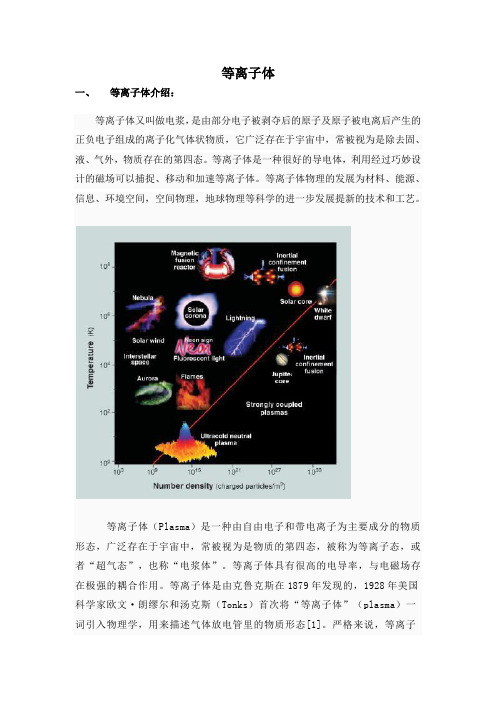
等离子体一、等离子体介绍:等离子体又叫做电浆,是由部分电子被剥夺后的原子及原子被电离后产生的正负电子组成的离子化气体状物质,它广泛存在于宇宙中,常被视为是除去固、液、气外,物质存在的第四态。
等离子体是一种很好的导电体,利用经过巧妙设计的磁场可以捕捉、移动和加速等离子体。
等离子体物理的发展为材料、能源、信息、环境空间,空间物理,地球物理等科学的进一步发展提新的技术和工艺。
等离子体(Plasma)是一种由自由电子和带电离子为主要成分的物质形态,广泛存在于宇宙中,常被视为是物质的第四态,被称为等离子态,或者“超气态”,也称“电浆体”。
等离子体具有很高的电导率,与电磁场存在极强的耦合作用。
等离子体是由克鲁克斯在1879年发现的,1928年美国科学家欧文·朗缪尔和汤克斯(Tonks)首次将“等离子体”(plasma)一词引入物理学,用来描述气体放电管里的物质形态[1]。
严格来说,等离子体是具有高位能动能的气体团,等离子体的总带电量仍是中性,借由电场或磁场的高动能将外层的电子击出,结果电子已不再被束缚于原子核,而成为高位能高动能的自由电子。
等离子体是物质的第四态,即电离了的“气体”,它呈现出高度激发的不稳定态,其中包括离子(具有不同符号和电荷)、电子、原子和分子。
其实,人们对等离子体现象并不生疏。
在自然界里,炽热烁烁的火焰、光辉夺目的闪电、以及绚烂壮丽的极光等都是等离子体作用的结果。
对于整个宇宙来讲,几乎99.9%以上的物质都是以等离子体态存在的,如恒星和行星际空间等都是由等离子体组成的。
用人工方法,如核聚变、核裂变、辉光放电及各种放电都可产生等离子体。
分子或原子的内部结构主要由电子和原子核组成。
在通常情况下,即上述物质前三种形态,电子与核之间的关系比较固定,即电子以不同的能级存在于核场的周围,其势能或动能不大。
等离子体由离子、电子以及未电离的中性粒子的集合组成,整体呈中性的物质状态.普通气体温度升高时,气体粒子的热运动加剧,使粒子之间发生强烈碰撞,大量原子或分子中的电子被撞掉,当温度高达百万开到1亿开,所有气体原子全部电离.电离出的自由电子总的负电量与正离子总的正电量相等.这种高度电离的、宏观上呈中性的气体叫等离子体.例如:等离子体造就的宇宙和自然奇观闪电极光星云太阳表面二、磁场对等离子体的运动影响:单粒子运动等离子体中带电粒子之间存在着电力,因此,这些粒子的运动是紧密耦合的。
等离子体技术
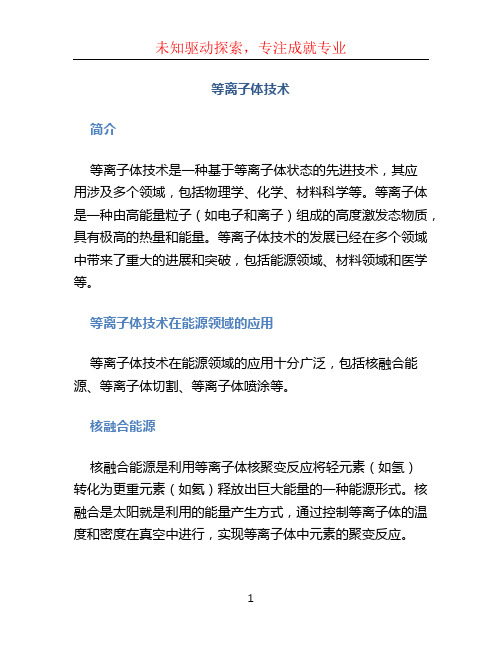
等离子体技术简介等离子体技术是一种基于等离子体状态的先进技术,其应用涉及多个领域,包括物理学、化学、材料科学等。
等离子体是一种由高能量粒子(如电子和离子)组成的高度激发态物质,具有极高的热量和能量。
等离子体技术的发展已经在多个领域中带来了重大的进展和突破,包括能源领域、材料领域和医学等。
等离子体技术在能源领域的应用等离子体技术在能源领域的应用十分广泛,包括核融合能源、等离子体切割、等离子体喷涂等。
核融合能源核融合能源是利用等离子体核聚变反应将轻元素(如氢)转化为更重元素(如氦)释放出巨大能量的一种能源形式。
核融合是太阳就是利用的能量产生方式,通过控制等离子体的温度和密度在真空中进行,实现等离子体中元素的聚变反应。
等离子体切割等离子体切割是利用高能等离子体射流来进行的一种材料切割技术,其具有高速、高能效、高精度的特点。
工业上常用的等离子体切割技术包括等离子弧切割和等离子火焰切割。
等离子体喷涂等离子体喷涂是利用等离子体射流将特殊涂料喷涂到材料表面的一种表面处理技术。
等离子体射流的高能量能够提高涂层的附着力和耐磨性,应用广泛于汽车、航空航天、电子等行业。
等离子体技术在材料领域的应用等离子体技术在材料领域的应用主要涉及表面处理、材料改性和薄膜制备等方面。
表面处理等离子体技术可以对材料表面进行清洗、活化和功能化处理。
例如,等离子体脱油技术可以去除材料表面的油污,提高粘接效果。
等离子体活化技术可以增加材料表面的活性官能团,提高涂层附着力。
等离子体功能化技术可以在材料表面引入特定功能化合物,赋予材料特殊的性能。
材料改性等离子体技术可以通过控制等离子体的能量和参数,改变材料的化学组成和物理性质。
例如,等离子体改性可以提高材料的硬度、耐磨性和抗腐蚀性。
此外,等离子体改性还可以改变材料的表面粗糙度和润湿性。
薄膜制备等离子体技术可以制备各种功能薄膜,如防反射膜、硬质膜和导电膜等。
利用等离子体沉积技术,可以实现对材料表面进行定向沉积,获得均匀、致密的薄膜。
等离子推进器原理

等离子推进器的基本原理1. 引言等离子推进器是一种利用电磁力将离子或等离子体排出以产生推力的推进器。
它是目前最先进、最高效的推进系统之一,被广泛应用于航天器、卫星和深空探测器等空间应用中。
本文将详细介绍等离子推进器的基本原理。
2. 等离子体的形成等离子体是由带正电荷的离子和带负电荷的电子组成的高度电离的气体。
在等离子推进器中,等离子体是通过电离气体来产生的。
一般情况下,气体通过电离源(如电离针或电离电极)进行电离,将其中的部分原子或分子电离为正离子和电子。
这些正离子和电子通过电场或磁场的作用被加速,并形成等离子体。
3. 等离子体加速等离子体在等离子推进器中的加速是通过电场或磁场的作用实现的。
3.1 电场加速在电场加速中,等离子体被放置在两个电极之间,形成一个电场。
电场的作用下,正离子和电子受到电场力的驱动,被加速并喷出推进器。
为了确保电场加速的效果,电极之间需要保持一定的电势差。
正离子和电子的加速方向相反,因此在推进器的设计中需要考虑如何使正离子和电子的运动方向一致,以最大程度地利用它们的动能。
3.2 磁场加速在磁场加速中,等离子体通过磁场的作用被加速。
磁场可以通过磁铁或线圈产生。
当等离子体穿过磁场时,正离子和电子的运动轨迹受到磁场力的影响,形成螺旋状轨迹。
通过调整磁场的强度和方向,可以控制等离子体的加速和排出方向。
4. 等离子体排出和推力产生等离子体在被加速后被排出推进器,形成推力。
排出等离子体的过程中,需要注意以下几个因素:4.1 离子排出由于正离子和电子具有相反的电荷,它们在排出过程中会受到相互作用力的影响。
为了最大限度地减小这种相互作用力的影响,推进器通常采用网状的阳极来排出正离子,而电子则通过中性化装置中和。
4.2 离子流束为了产生高效的推力,等离子体需要以高速排出。
离子流束的速度取决于等离子体的加速方式和加速能量。
为了确保离子流束的稳定性和一致性,推进器通常采用多级加速结构,以逐级加速离子。
等离子体百科

等离子体等离子体等体又叫做电浆,是由部份电子被剥夺后的及原子被后产生的正负电子组成的离子化气体状物质,它普遍存在于中,常被视为是除去固、液、气外,物质存在的第四态。
等离子体是一种专门好的,利用通过巧妙设计的磁场能够捕捉、移动和加速等离子体。
的进展为材料、能源、信息、环境空间,,地球物理等科学的进一步进展提新的技术和工艺。
简介看似“神秘”的等离子体,实际上是中一种常见的物质,在、、中都存在等离子体,它占了整个宇宙的99%。
21世纪人们已经把握和利用电场和磁场产生来操纵等离子体。
例如焊工们用焊接金属。
等离子体可分为两种:高温和。
低温等离子体普遍运用于多种等离子体生产领域。
例如:,婴儿尿布表面防水涂层,增加啤酒瓶阻隔性。
更重要的是在中的蚀刻运用,让成为现实。
只有在温度足够高时发生的。
和恒星不断地发出这种等离子体,组成了宇宙的99%。
是在下发生的等离子体(尽管电子的温度很高)。
低温等离子体体能够被用于、变性等表面处置或在和上进行沉淀涂层处置。
等离子体(Plasma)是一种由和带电为要紧成份的物质形态,普遍存在于中,常被视为是物质的第四态,被称为等离子态,或“超气态”,也称“电浆体”。
等离子体具有很高的,与存在极强的作用。
等离子体是由在1879年发觉的,1928年美国科学家和汤克斯(Tonks)第一次将“等离子体”(plasma)一词引入,用来描述气体放电管里的物质形态[1]。
严格来讲,等离子体是具有高动能的气体团,等离子体的总带电量仍是中性,借由或磁场的高动能将外层的电子击出,结果电子已再也不被束缚于,而成为高位能高动能的自由电子。
等离子体是物质的第四态,即电离了的“气体”,它呈现出高度激发的不稳固态,其中包括(具有不同符号和电荷)、电子、原子和分子。
其实,人们对等离子表现象并非生疏。
在里,灼热烁烁的火焰、辉煌夺目的、和绚烂壮丽的等都是等离子体作用的结果。
关于整个宇宙来讲,几乎99.9%以上的物质都是以等离子体态存在的,如和行星际空间等都是由等离子体组成的。
等离子体的原理和应用
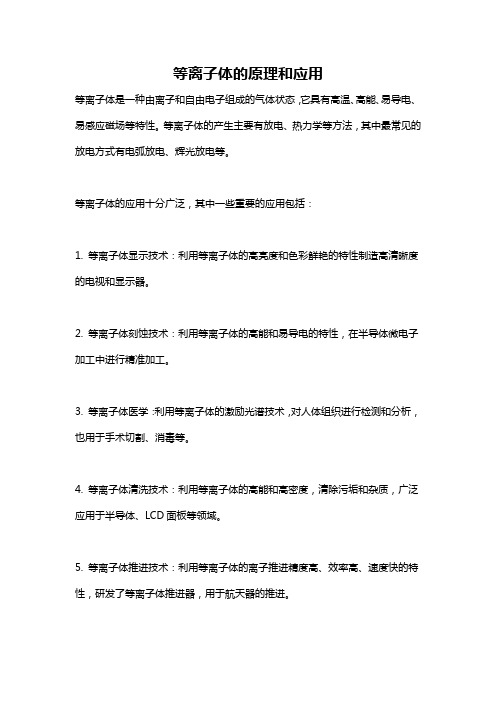
等离子体的原理和应用
等离子体是一种由离子和自由电子组成的气体状态,它具有高温、高能、易导电、易感应磁场等特性。
等离子体的产生主要有放电、热力学等方法,其中最常见的放电方式有电弧放电、辉光放电等。
等离子体的应用十分广泛,其中一些重要的应用包括:
1. 等离子体显示技术:利用等离子体的高亮度和色彩鲜艳的特性制造高清晰度的电视和显示器。
2. 等离子体刻蚀技术:利用等离子体的高能和易导电的特性,在半导体微电子加工中进行精准加工。
3. 等离子体医学:利用等离子体的激励光谱技术,对人体组织进行检测和分析,也用于手术切割、消毒等。
4. 等离子体清洗技术:利用等离子体的高能和高密度,清除污垢和杂质,广泛应用于半导体、LCD面板等领域。
5. 等离子体推进技术:利用等离子体的离子推进精度高、效率高、速度快的特性,研发了等离子体推进器,用于航天器的推进。
总之,等离子体的原理和应用在现代科技中扮演着重要的角色,其研究和应用将会继续推动科技的发展。
等离子体推进器的工作原理

等离子体推进器的工作原理人们把电火箭推进器称为等离子体推进器,它的特点是推进器的工作物质为电中性的等离子体并在电磁场中被加速。
电火箭中的等离子体具有非常高的电离度,进入推进器的90%~95%的原子被电离成单电荷的离子。
加速等离子体——这要同时加速它的俩种成分:电子和离子。
但是电火箭的特征速度为每秒100千米,电子在加速电位差达到2103-⨯伏时就能轻易的获得这个速度,所以在电火箭里加速电子是不存在问题的。
等离子体推进器实质上就是像离子推进器一样要加速离子。
然而在等离子体推进器中的电子也有重要的作用:在等离子体推进器里原子的电离是借助电子轰击产生的;在加速离子的通道里电子中和了离子的空间电荷,从而消除了空间电荷对等离子体推进器特性可能产生的各种不利的影响,特别应强调指出的是:等离子体推进器内电子在离子加速的过程中同样也起着关键性的作用。
在完全电离的稀薄等离子体中离子的运动方程可写成如下形式:)(B e jn p E e dt d m i i i i⨯+-∇-=νσν (1) 在这里,e i ,ν和i m 分别表示离子的速度、电荷和质量,n 和σ表示等离子体的密度和电导率,E ——电场强度,B——磁感应强度,i p ∇——离子的压强梯度,j——电流密度。
加速离子,也就是增加它的速度值,只能借助于离子运动方程(1)右边的前三种力,第四种力即洛伦兹力只能改变速度的方向。
相应的,电场力E e 对离子的加速叫做净电加速(或者电加速);压强力n p i ∇对离子的加速叫做气体动力学加速(或者热加速);力σje 加速称作欧姆加速(或者更形象地称作电子风加速)。
静电等离子体推进器是等离子体推进器中的一种,在它里面离子是由电场加速的,电场是在磁极之间环形孔道内的等离子体里产生的(见图1),它的工作原理是在磁极之间环形孔内的等离子体中,由于磁场使电子的横向迁移率急剧的减少,而产生很大的感应电场,加速了离子。
图1 电等离子体发动机的示意图(具有闭合的电子漂移轨道)1---磁体,2---阳极(同时也是蒸汽分布器) 3---阴极(同时也是电子补偿器) B ---磁感应强度,E---电场强度在电等离子体推进器中磁场要这样选取,它既能使电子完全磁化,即电子的拉莫半径eρ远小于加速通道的长L和宽b(b L e,<<ρ),同时又保障离子的非磁化,即使离子的拉莫半径i ρ远大于加速通道的长度L (L i >>ρ)。
等离子发动机 算式 -回复

等离子发动机算式-回复等离子发动机是一种高效能的推进系统,它利用等离子体的特性产生巨大的推力。
下面,我们将逐步解释等离子发动机的原理和运作过程。
首先,我们来了解什么是等离子体。
等离子体是第四态物质,它由带电粒子(正离子和自由电子)组成。
在常规的物质中,原子和分子之间的电荷是平衡的,但在高能环境中,如高温或高电压下,原子或分子会被剥离产生自由电子和正离子,形成等离子体。
接下来,我们讨论等离子发动机是如何利用等离子体来产生推力的。
等离子发动机的原理是基于离子推力原理,即通过加速和排放离子来产生推力。
首先,等离子体产生器会将一个混合气体(通常为氧和氢)转化成等离子体。
这个过程需要提供能量,通常通过电弧放电来实现。
然后,等离子体在磁场的作用下被加速,形成离子束。
离子束通过喷嘴排放出来,并在相反的方向上产生反作用力,从而推动发射器或飞行器。
等离子发动机的输出推力与排放的离子质量和速度有关。
质量可以通过控制气体的种类和比例来调节,速度可以通过加速电场和磁场的强度来控制。
通过优化这些参数,可以实现不同推力要求和燃料效率的平衡。
虽然等离子发动机的推力相对较小,但它具有一些独特的优点。
首先,等离子发动机可以提供连续的推力,相对于化学发动机的瞬间爆发更加稳定。
其次,等离子发动机不依赖于氧气,可以在真空中工作,这使其成为太空探测器的理想选择。
此外,等离子发动机的燃料效率较高,因为它可以利用电能直接将气体转化成等离子体,而不需要经过燃烧反应。
然而,等离子发动机也存在一些挑战。
首先,产生和维持等离子体需要大量的能量输入。
现有的等离子体发电技术还无法满足实际应用的需求,能量效率有待提高。
其次,等离子发动机需要较长的加速时间达到较高的速度,因此在航天应用中仍面临一定的限制。
总的来说,等离子发动机是一种潜力巨大的推进系统。
随着技术的进步和应用领域的拓展,等离子发动机有望在未来的太空探测、科学研究和甚至商业领域迎来更广泛的应用。
等离子体电动力学

等离子体电动力学
等离子体电动力学是物理学中的一个重要分支,是研究等离子体(plasma)运动规
律的科学。
等离子体运动受到多种因素的影响,包括引力,磁力和电磁力等,其中电磁力更是推动等离子体运动的主因,这就是等离子体电动力学的基本概念。
研究等离子体电动力学的基础是理论,实验与计算方法的结合。
理论上,从电学、磁学和可燃气体流体力学出发,利用数学技术和计算机技术,研究等离子体的磁场及
温度在电磁力作用下的变化规律;实验上,以同步辐射和等离子体交换作用为研究
对象,研究电场和磁场在物理现象中对等离子体运动的作用;通过计算及分析,研究
电磁场强度在特定条件下,等离子体的流动规律,总结形成等离子体电动力学的全貌。
等离子体电动力学在工程应用上非常广泛,可以用于抛射热和磁束体以及等离
子体动力系统,它也可以用于制造等离子体推进装置,等离子体本身也可用来制备纳
米材料、强化金属和微尺度结构等。
综上所述,可见等离子体电动力学的研究具有十分重要的意义,它不仅丰富和拓
展了物理学的理论体系,而且为等离子体技术及其应用提供了有力的理论支撑。
因此,在未来,等离子体电动力学的研究将越来越受到重视,对促进人类社会进步具有重要的意义。
等离子体点火系统基础讲义分析

等离子体点火系统基本介绍简介1.等离子体基本介绍等离子体是由部分电子被剥夺后的原子及原子被电离后产生的正负电子组成的离子化气体状物质,常被视为是除去固、液、气外,物质存在的第四态。
等离子体是一种很好的导电体。
等离子体内含有大量化学活性的粒子,如原子(C、H、0)、原子团(OH、H2、02)、离子(02 —、H2 —、0H —、0 —、H + )和电子等,可加速热化学转换,促进燃料完全燃烧;等离子体对于煤粉的作用,可比通常情况下提高20%〜80%的挥发份,即等离子体有再造挥发份的效应,这对于点燃低挥发份煤粉强化燃烧有特别的意义。
(与小油枪的优势)2.等离子体点火系统的产生我们公司90上世纪年代是做炉前油系统(油枪,高能点火器,油点火枪,可见光火检,红外火检,FSSS系统)后来开发了图像火焰监视系统。
在上世纪90年代末,油价飞速增长,在前人的实验基础上,经过公司大量的工业试验,研制成功的。
在烟台电厂和佳木斯电厂最开始商业应用。
02年率先600MW机组,盘山电厂安装了等离子体点火系统。
同时期国产DCS厂家新华,和利时还在为了600MW级没有业绩而四处奔走,这也体现了公司的高瞻远崛,每次都抓住了历史赐予我们的机遇。
3.公司的业绩和面临的发展形势公司的无燃油燃煤电站可能继等离子体点火技术之后再次获得国家科技进步奖。
公司的十二五规划,到2015年,实现收入60亿元,利润8亿元。
4 •煤质等离子体点火技术是应用在煤粉锅炉的一项技术,不会用来点油,或者天然气,大材小用。
等离子体点火技术目前公司分为常规的发生器和燃烧器以及大功率的发生器和燃烧器。
标准煤质如下:Marv 15%, Aadv35%, Vad>20%, Qnet, ar> 17000kJ/kg (不包括褐煤)这样的煤质可以使用常规的发生器和燃烧器,不需要公司工业实验。
褐煤,劣质烟煤,贫煤都需要做实验来决定,一般采用大功率的发生器和燃烧器。
下面简要说说煤的分类:煤中的元素组成,一般是指有机物质中的碳(C)、氢(H)、氧(0)、氮(N)和硫(S)的含量。
新型电推进技术在宇宙探索中的应用研究

新型电推进技术在宇宙探索中的应用研究随着科技的不断进步,人类对宇宙的探索也越来越深入。
而在宇宙探索的过程中,电推进技术起到了极为重要的作用。
本文将从电推进技术的概念、原理、种类以及应用方面来介绍一下电推进技术在宇宙探索中的应用研究。
一、电推进技术的概念电推进技术,即电子推进技术(Electric Propulsion,简称 EP),指的是利用电力推进系统的宇航器推进技术。
在电推进技术中,通常是利用离子、等离子体或电磁场与气体分子或固体微粒相互作用,以推进宇航器的飞行。
电推进技术相比传统的化学推进技术,具有比冲高、推力小、耗气小、可控性好、长时间推进等优点。
二、电推进技术的原理电推进技术的原理主要是依靠电磁场实现推进,具体地说,就是通过电场或磁场将粒子加速到高速,并以高速粒子撞击气体分子或微粒子的方式来产生推进力。
根据工作原理来看,电推进技术可以分为离子推进技术、电阻推进技术、磁流体推进技术、电弧发动机推进技术等。
三、电推进技术的种类(一)离子推进技术(IPT)离子推进技术是目前发展比较成熟的一种电推进技术,广泛应用于卫星和深空探测任务中。
离子推进技术是基于离子引擎(Ion Engine)实现的。
离子引擎通过将气体原子或分子电离,随后再加速这些离子,从而产生推进力。
离子推进技术的比冲和耗气极低,可以让探测器长时间地保持在其轨道上,并帮助它们较快地到达目的地。
(二)电阻推进技术(.Resistojet)电阻推进技术是一种利用电阻发生劫持、自发热而产生推进力的技术。
受热后的气体会增加分子的速度和能量,加速气体的扩散,形成推进气流。
电阻推进技术主要用于小型便携式的宇宙飞行器,特别是在卫星调整或姿态控制方面发挥着重要的作用。
(三)磁流体推进技术(Magnetoplasmadynamic.thruster,简称 MPT)磁流体推进技术是通过利用加热磁流体,使其成为等离子体,然后通过磁场控制等离子体运动,从而实现推进。
等离子发动机

简介
简介
在科幻小说中,飞行器总能为星际旅行的全程提供动力。但在现实中,火箭推进器的发动机技术,根本无法 实现这一点。
相对于裸露在外的推进剂储箱,化学火箭的发动机看上去很小,但它的胃口很大。“吃得多,干活的效率却 不高。”张福林说。这种发动机吞噬掉的海量能源,只在提供短期动力方面有效——储存的燃料很快用完,推进 器马上被当成垃圾扔掉。化学火箭的大部分燃料被用来摆脱地球引力,剩余的一点则被用来推动火箭的“太空滑 行”。火箭飞往目的地,仅仅是依靠惯性。对于星际飞行来说,这种引擎显然力不从心。
VASIMR,全功率可变比冲的磁等离子体火箭(Variable-specific-impulse magnetoplasma rocket), 尽管离最终完善仍有距离,但已经在航天界中引起了巨大反响。
只差一步
只差一步
建造VASIMR就是张福林在20世纪70年代提出的主意。它能同时具有化学火箭发动机和离子发动机的能力。 传统化学火箭发动机拥有高推力、低比冲,离子发动机则是低推力、高比冲。而VASIMR,它能在高推力、低比冲 和低推力、高比冲之间的自由转换,在这两者之间调整参数,所以被称作“可变比冲”。
张福林一直致力于该项目研究,但之后的20多年里他忙于作为宇航员7次进入太空。直到2005年,他从NASA 退役组建了Ad Astra火箭公司,试验场就在他的出生地哥斯达黎加附近的航空中心。
电推进原理与典型结构

Kosmos
Luch-1
8.0引言—应用情况
电推进卫星应用之二:GEO卫星南北位保(NSSK)
1981年TRW公司肼电热首次应用于Intelsat-502 1983年AR公司MR-501肼电热应用于Satcom-1R 1987年AR公司MR-502肼电热开始应用,并延续至今 肼电热先后应用于150个航天器(包括95颗铱星)
Intelsat-502
Satcom-1R
8.0引言—应用情况
电推进卫星应用之二:GEO卫星南北位保(NSSK) 1993年AR公司肼电弧首次应用于洛马Telstar-401 AR公司MR510肼电弧一直应用于洛马公司A2100平台 MR510的主要性能:功率2kW、比冲585s、寿命1730h
8.0引言—发展历程
发展现状概括
国家和部门不断增多:从美国、俄罗斯、日本、德国、英国、 法国、意大利等发达国家扩展到中国、巴西、乌克兰、韩国、 印度和以色列等发展中国家。每个国家电推进技术研究部门日 益增加
国际合作日益加强:1991年SS/L和俄罗斯火炬设计局联合成立 国际空间技术公司(ISTI)向西方推广SPT-100电推进,目前已 经形成LS-1300、ES-3000、SB-40000平台的批量应用;2010年 美国AEROJET和日本NEXC签署协议联合开发低功率离子电推进系 统在美国的宇航市场
V
m m p
i
1
e
gI sp
V
gIsp
ln
mi mf
8.0引言—概念与特点
对现代航天器而言,应用电推进的必要性和重要越来越凸显
赢得通信卫星市场竞争的筹码,包括降低成本、提升性价 比、工作延长寿命等方面
8.0引言—概念与特点
等离子体推动器

等离子体推动器一、为什么要使用电推动器?1.传统化学推进剂的缺点:(a)在深空探测中,化学推进剂占航天器重量的绝大部分,有效载荷小,效率低,造价高。
-(附:肼(联氨)-----一种无色发烟的、具有腐蚀性和强还原性的液体化合物NH2 NH[hydrazine],它是比氨弱的碱,通常由水合肼脱水制得,燃烧热较大主要用作火箭2和喷气发动机的燃料,用在制备盐(如硫酸盐)及有机衍生物中)在探索更远的星球时,化学燃料推动已不可行。
(b)通信卫星长寿命增加(15 年),为保持轨道定点位置,所需的推进剂越来越多(使用次数愈来愈多),大量挤占了有效载荷的重量。
因此,大型通信卫星的推进系统改用电推进已势在必行。
目前航天领域广泛使用的化学火箭发动机,对于完成航天器从地面向空间轨道的发射任务,还难以用其它动力装置代替。
但由于化学推进的比冲偏小,最大不超过4.6kN*s/kg,所以,如果对于航天器的轨道转移、轨道修正、姿态控制、对接交会、位置保持、南北轨控和星际航行等特殊任务仍然采用化学动力装置,那么就会使一直昂贵的航天器发射成本居高不下,而且也会严重影响其使用寿命。
2.电推进器的优缺点优点:(a)效率高―――喷射离子速度远高于化学燃烧气体粒子速度;电推进技术的推进剂效率(或比冲) 是化学推进系统的几倍甚至几十倍(b)所需重量降低;(c)最终速度高(化学推进剂: 5 km/s,电推动:10-20 km/s)。
缺点:推力小,加速时间长,需要电源,二、推进器的任务✹轨道转移;✹遥感卫星的轨道调整和姿态控制;✹通讯卫星的轨道保持;✹深空探测;三、电推进简史1.国际电推动发展史☞第一次离子推动实验室实验By 1916 Goddard and his students were conducting perhaps the world's first electric propulsion experiments with ion sources. Four years later Goddard devoted passages of his technical reports to his EP experiments.☞第一次电推动飞行实验世界上首次电推进(脉冲等离子体推进) 空间飞行试验是前苏联于1962 年进行的;(该次发射的意义:标志科学界已接受电推进技术,进入一个新的历史时期:不再是证明电推进是否有价值的时期,而是解决静电推进存在的问题。
等离子体

等离子体摘要等离子体是由部分电子被剥夺后的原子及原子被电离后产生的正负电子组成的离子化气体状物质。
它的用途非常广泛.从我们的日常生活到工业、农业、环保、军事、宇航、能源、天体等方面,它都有非常重要的应用价值,并拥有广泛的应用前景。
主题词等离子体、环境1.基本概述等离子体又叫做电浆,是由部分电子被剥夺后的原子及原子被电离后产生的正负电子组成的离子化气体状物质,它广泛存在于宇宙中,常被视为是除去固、液、气外,物质存在的第四态。
等离子体是一种很好的导电体,利用经过巧妙设计的磁场可以捕捉、移动和加速等离子体。
等离子体物理的发展为材料、能源、信息、环境空间,空间物理,地球物理等科学的进一步发展提新的技术和工艺。
看似“神秘”的等离子体,其实是宇宙中一种常见的物质,在恒星(例如太阳)、闪电中都存在等离子体,它占了整个宇宙的99%。
现在人们已经掌握利用电场和磁场产生来控制等离子体。
例如焊工们用高温等离子体焊接金属。
2.分类2.1 按等离子体焰温度高温等离子体:温度相当于10~10 K完全电离的等离子体,如太阳、受控热核聚变等离子体。
低温等离子体:热等离子体:稠密高压(1大气压以上),温度10~10K,如电弧、高频和燃烧等离子体。
冷等离子体:电子温度高(10~10K)、气体温度低,如稀薄低压辉光放电等离子体、电晕放电等离子体、DBD介质阻挡放电等离子体、索梯放电等离子体等。
2.2按等离子体所处的状态(1)平衡等离子体:气体压力较高,电子温度与气体温度大致相等的等离子体。
如常压下的电弧放电等离子体和高频感应等离子体。
(2)非平衡等离子体:低气压下或常压下,电子温度远远大于气体温度的等离子体。
如低气压下DC辉光放电和高频感应辉光放电,大气压下DBD介质阻挡放电等产生的冷等离子体。
3.等离子技术的应用现状3.1等离子体冶炼用于冶炼用普通方法难于冶炼的材料,例如高熔点的锆(Zr)、钛(Ti)、钽(Ta)、铌(Nb)、钒(V)、钨(W)等金属;还用于简化工艺过程,例如直接从ZrCl、MoS、TaO和TiCl中分别获得Zr、Mo、Ta和Ti;用等离子体熔化快速固化法可开发硬的高熔点粉末,如碳化钨-钴、Mo-Co、Mo-Ti-Zr-C等粉末等离子体冶炼的优点是产品成分及微结构的一致性好,可免除容器材料的污染3.2等离子体喷涂许多设备的部件应能耐磨耐腐蚀、抗高温,为此需要在其表面喷涂一层具有特殊性能的材料。
电推进技术-3

2 MPDT工作机制及附加磁场MPDT关键问题
• MPDT又可分为自身场SF-MPDT(Self-field MPDT) 和附加场AF-MPDT(Applied-field MPDT)两种类 型。
• 那么如何才能更好地施加Lorentz的影响呢?
2 MPDT工作机制及附加磁场MPDT关键问题
• 非常聪明的办法就是采用附加磁场。 • 发动机由中心阴极和安装在喷管出口扩张段的同轴环型
阳极组成,其阴极、阳极外围缠绕被磁化的线圈或安装 永久磁铁,这种布置将产生“附加”的磁场,从而更好 地施加Lorentz的影响。 • 附加磁场带来的另一个优点是:可以在较低功率水平上 得到高的发动机性能参数。 • 有附加磁场的时候,MPD推力产生的机理变得十分复杂。
• 结果显示,放电电压和阳极功率沉积取决于附加磁场的半径, 内径15.2cm的线圈磁场强度0.14T时,得到阳极功率分数最小为 66%;内径12.7cm的线圈磁场强度0.04T时,阳极功率分数最高 为80%。其表明可以通过优化设计磁场来提高发动机性能。羽流 电子数密度为2´1018~4´1018,电子温度为35000~50000K。
• 从理论上讲,MPDT能够产生极高的比冲,其值 能够达到11000s,排气速度能够达到110km/s, 是当前已投入使用的氙离子发动机的三倍,是 液体火箭发动机的20倍。
1 背景
• 其最有吸引力之处还在于MPDT的推力能够达到 200N,因而可以实现航天器快速轨道机动,并 可能是未来月球、火星、外层空间往返的主要 运输工具。
电推进技术
第三章 磁等离子体推进
• 背景 • MPDT工作机制及附加磁场MPDT关键问题 • 研究现状及分析 • MPDT理论模型和仿真研究现状 • 国内研究现状 • 问题和争议 • 典型设计
卫星进入“小时代”
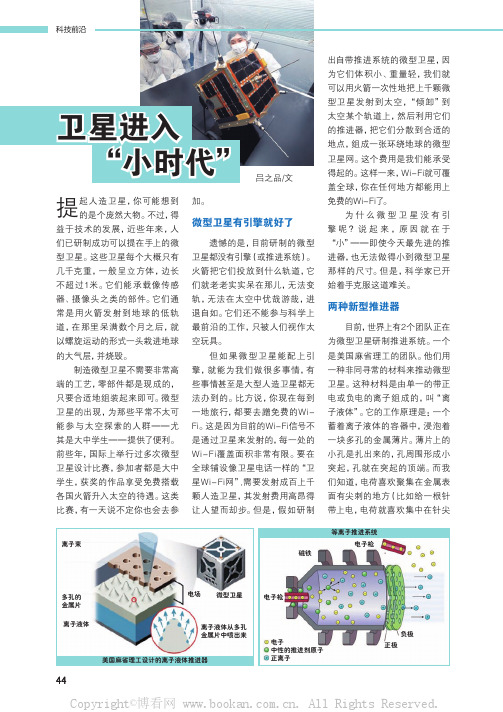
提起人造卫星,你可能想到的是个庞然大物。
不过,得益于技术的发展,近些年来,人们已研制成功可以提在手上的微型卫星。
这些卫星每个大概只有几千克重,一般呈立方体,边长不超过1米。
它们能承载像传感器、摄像头之类的部件。
它们通常是用火箭发射到地球的低轨道,在那里呆满数个月之后,就以螺旋运动的形式一头栽进地球的大气层,并烧毁。
制造微型卫星不需要非常高端的工艺,零部件都是现成的,只要合适地组装起来即可。
微型卫星的出现,为那些平常不太可能参与太空探索的人群——尤其是大中学生——提供了便利。
前些年,国际上举行过多次微型卫星设计比赛,参加者都是大中学生,获奖的作品享受免费搭载各国火箭升入太空的待遇。
这类比赛,有一天说不定你也会去参加。
微型卫星有引擎就好了遗憾的是,目前研制的微型卫星都没有引擎(或推进系统)。
火箭把它们投放到什么轨道,它们就老老实实呆在那儿,无法变轨,无法在太空中优哉游哉,进退自如。
它们还不能参与科学上最前沿的工作,只被人们视作太空玩具。
但如果微型卫星能配上引擎,就能为我们做很多事情,有些事情甚至是大型人造卫星都无法办到的。
比方说,你现在每到一地旅行,都要去蹭免费的Wi-Fi。
这是因为目前的Wi-Fi信号不是通过卫星来发射的,每一处的Wi-Fi覆盖面积非常有限。
要在全球铺设像卫星电话一样的“卫星Wi-Fi网”,需要发射成百上千颗人造卫星,其发射费用高昂得让人望而却步。
但是,假如研制出自带推进系统的微型卫星,因为它们体积小、重量轻,我们就可以用火箭一次性地把上千颗微型卫星发射到太空,“倾卸”到太空某个轨道上,然后利用它们的推进器,把它们分散到合适的地点,组成一张环绕地球的微型卫星网。
这个费用是我们能承受得起的。
这样一来,Wi-Fi就可覆盖全球,你在任何地方都能用上免费的Wi-Fi了。
为什么微型卫星没有引擎呢?说起来,原因就在于“小”——即使今天最先进的推进器,也无法做得小到微型卫星那样的尺寸。
但是,科学家已开始着手克服这道难关。
美国大学研发等离子推进引擎系统助NASA探火星
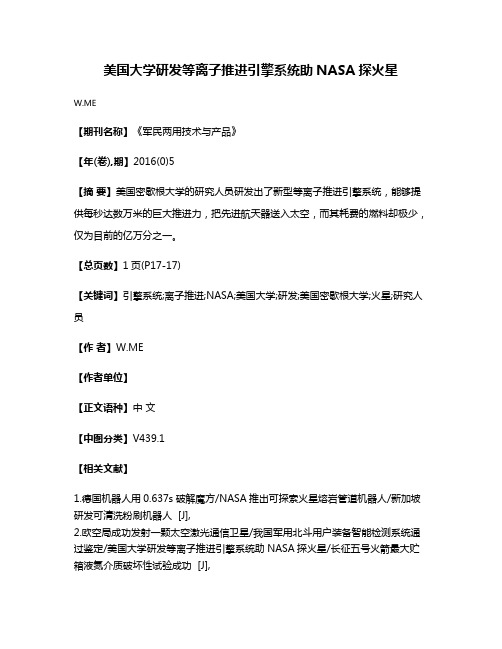
美国大学研发等离子推进引擎系统助NASA探火星
W.ME
【期刊名称】《军民两用技术与产品》
【年(卷),期】2016(0)5
【摘要】美国密歇根大学的研究人员研发出了新型等离子推进引擎系统,能够提供每秒达数万米的巨大推进力,把先进航天器送入太空,而其耗费的燃料却极少,仅为目前的亿万分之一。
【总页数】1页(P17-17)
【关键词】引擎系统;离子推进;NASA;美国大学;研发;美国密歇根大学;火星;研究人员
【作者】W.ME
【作者单位】
【正文语种】中文
【中图分类】V439.1
【相关文献】
1.德国机器人用0.637s破解魔方/NASA推出可探索火星熔岩管道机器人/新加坡研发可清洗粉刷机器人 [J],
2.欧空局成功发射一颗太空激光通信卫星/我国军用北斗用户装备智能检测系统通过鉴定/美国大学研发等离子推进引擎系统助NASA探火星/长征五号火箭最大贮箱液氮介质破坏性试验成功 [J],
3.NASA研发可在火星上飞行的无人直升机 [J],
4.BEA助NASA探索火星之旅 [J],
5.NASA研制登陆火星用的电力推进系统 [J],
因版权原因,仅展示原文概要,查看原文内容请购买。
- 1、下载文档前请自行甄别文档内容的完整性,平台不提供额外的编辑、内容补充、找答案等附加服务。
- 2、"仅部分预览"的文档,不可在线预览部分如存在完整性等问题,可反馈申请退款(可完整预览的文档不适用该条件!)。
- 3、如文档侵犯您的权益,请联系客服反馈,我们会尽快为您处理(人工客服工作时间:9:00-18:30)。
fe
= ne
⎛ ⎜ ⎝
me 2πkTe
3
⎞2 ⎟ ⎠
- mec2e
e 2kTe
;
( ) c2e
=
c2ex
+ c2ey
+
c2
ez
(14)
With the normalization
∫ ∫ ∫ fed3ce = ne .
The mean velocity is then
∫ ∫ ∫ ce ≡
ce fed3ce
The
current
density
is the flux of charge due to motion of all charges. If only the electron motion is
counted (it dominates in this case)
G
JG
j ≡ -ene Ve
(10)
cancelling remainder is Ve . Think of a swarm of bees moving furiously to swarm) slowly.
G The number of electrons per unit volume that have a velocity vector c ending in a
ne = -S +
S2 + Sn = 1+
n
1
+
S
n
(T
)
(6)
Since S increases very rapidly with T, the limits of (6) are
( ) ne ⎯⎯T⎯→0⎯⎯→
Sn → 0 T →0
(Weak ionization)
ne
⎯⎯T⎯→∞⎯⎯→
n 2
k = Boltzmann constant = 1.38 ×10-23 J/K
(Note: k = R/Avogadro’s number) h = Plank’s constant = 6.62x10-34 J.s. Vi = Ionization potential of the atom (volts) (Vi = 13.6 V for H)
(Full ionization)
G OG nce an electron population exists, an electric field E will drive a current density j through the plasma. To understand this quantitatively, consider the momentum
A normal gas at T <∼ 3000K is a good electrical insulator, because there are almost no free electrons in it. For pressure >∼ 0.1 atm, collision among molecule and other particles are frequent enough that we can assume local Thermodynamic Equilibrium, and in particular, ionization-recombination reactions are governed by the Law of Mass Action. Consider neutral atoms (n) which ionize singly to ions (i) and electrons (e):
NOTE:
c is e
very
different
(usually
much
larger)
than
Ve .
Most
of
the
thermal
motion
is
fast,
but in random directions, so that on average it nearly cancels out. The non-
(5)
Combining (3’) and (5),
n2e
=
S
(
T
)
⎛ ⎜⎝
P kT
-
2ne
⎞ ⎟⎠
=
S
(T ) (n
-
2ne
)
Where n = P is the total member density of all particles. kT
We then have
n2e + 2Sne - Sn = 0
and direct calculation gives
ce =
8 kTe π me
For Hydrogen atoms,
(15)
ce = 6210 Te
(m/s, with Te in K)
(16)
NOTE:
If there is current, the distribution cannot be strictly Maxwellian (or even isotropic). But since Ve << ce, the mean thermal velocity is very close to Equation (15) anyway.
with some other particle (neutral or ion). Collisions with other electrons are not
counted, because the momentum transfer is in that case internal to the electron
e
“box”
dcex dcey dcez ≡ d3ce in velocity space is defined as
( )G
fe ce d3ce
( ) G JG
Where
fe
ce ,x
is the Distribution function of the JG
electrons which depends (for a Ggiven location x and time
Electrons moving at random with (thermal) velocity ce intercept the area Qen at a rate equal to their flux neceQen . Since a whole range of
speeds ce exists, we use the average
( ) t)
on
the
three
components JJG
of
ce .
In
an
equilibrium
situation all directions are equally likely, so fe = fe ce = fe (ce ) only, and one can
show that the form is Maxwellian.
momentum is fully given up. Suppose there are νe of these collisions per second
( νe
=collision
JG
frequency JJG
per
electron).
The
electron
loses
momentum
at
a
rate
16.522, Space Propulsion Prof. Manuel Martinez-Sanchez Lecture 10: Electric Propulsion - Some Generalities on Plasma (and Arcjet
Engines)
Ionization and Conduction in a High-pressure Plasma
should be nn ceQen . Adding the part due to ions,
νe = nn ceQen + ni ceQei
(13)
16.522, Space Propulsion Prof. Manuel Martinez-Sanchez
Lecture 10 Page 3 of 12
Except for very narrow “sheaths” near walls, plasmas are quasi-neutral:
ne = ni
(4)
So that
n2e = S (T )
(3’)
nn
can be used.
16.522, Space Propulsion Prof. Manuel Martinez-Sanchez
and from (9),
G j
=
⎛ ⎜⎜⎝
e2ne meνe
⎞G ⎟⎟⎠
E
(11)
The group
σ = e2νe meνe
(12)
is the conductivity of the plasma (Si/m).
Let us consider the collision frequency. Suppose a neutral is regarded as a sphere with a cross-section area Qen.
Lecture 10 Page 2 of 12
GG FE + FFriction = 0,
